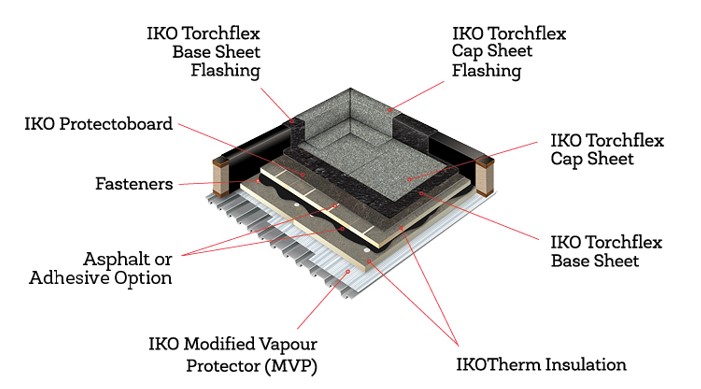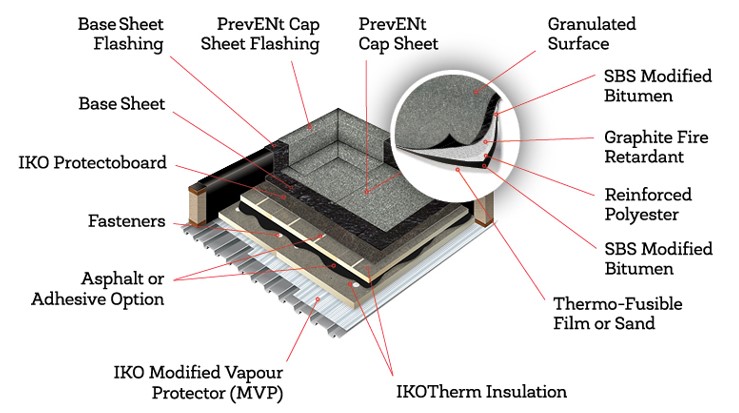When it comes to commercial roofs, there is much more than meets the eye. Wondering what materials are used to construct these sturdy structures? From metal to asphalt, commercial roofs are crafted with a variety of materials to ensure durability, longevity, and protection against the elements. Understanding what a commercial roof is made of is essential for businesses and property owners alike, so let’s dive into the fascinating world of commercial roofing materials and discover the secrets behind their construction.

Understanding Commercial Roofs
Commercial roofs are essential components of any commercial building, providing protection from the elements and maintaining the integrity of the structure. Understanding the different materials used in commercial roofing is crucial in order to make informed decisions about the best options for your building. From single-ply membranes to green roofs and photovoltaic systems, there is a wide range of materials available, each with its own advantages and disadvantages.
Common Commercial Roofing Materials
Single-Ply Membrane
One of the most popular types of commercial roofing material is the single-ply membrane. This material is made from a flexible synthetic polymer, typically either EPDM (ethylene propylene diene monomer), TPO (thermoplastic olefin), or PVC (polyvinyl chloride). Single-ply membranes are lightweight, durable, and easy to install, making them a cost-effective choice for many commercial building owners. They also offer excellent resistance to UV rays and chemical exposure, providing long-lasting protection for your roof.
Built-Up Roofing (BUR)
Built-up roofing (BUR) is a tried and true method of commercial roof construction that has been used for many years. It consists of multiple layers of bitumen, typically asphalt or coal tar, alternating with layers of reinforcing fabric, such as fiberglass or organic felts. BUR roofs offer excellent waterproofing and durability, and they can withstand heavy foot traffic and extreme weather conditions. While BUR roofs require more labor and time to install compared to other roofing systems, they have a long lifespan and are highly resistant to punctures and tears.
Metal
Metal roofs are known for their longevity and durability, making them a popular choice for commercial buildings. Typically made from steel, aluminum, or copper, metal roofs are resistant to fire, pests, and rot. They also have excellent reflective properties, helping to reduce energy costs by keeping the building cool in hot climates. Metal roofs can be installed as standing seam, metal panel or metal shingle systems, providing a range of aesthetic options. While metal roofs may have a higher upfront cost, they offer exceptional long-term value due to their low maintenance and long lifespan.
Modified Bitumen
Modified bitumen roofs are a type of asphalt-based roofing system that combines the durability of built-up roofing with the ease of installation of single-ply membranes. They are made by adding modifiers, such as polymers or rubber, to the asphalt. Modified bitumen roofs are known for their elasticity, allowing them to expand and contract with temperature changes without cracking. They are also resistant to UV rays, providing excellent protection against the sun’s harmful effects. With proper maintenance, modified bitumen roofs can have a lifespan of up to 20 years.
Ethylene Propylene Diene Monomer (EPDM)
EPDM roofs are single-ply membranes made from a synthetic rubber compound. They are known for their exceptional weather resistance, able to withstand extreme temperatures, UV radiation, and ozone exposure without degradation. EPDM roofs are highly durable, with a typical lifespan of 20 to 30 years, and they require minimal maintenance. Their flexibility and ability to easily accommodate building movements make them a popular choice for commercial buildings.
Thermoplastic Olefin (TPO)
TPO roofs are another type of single-ply membrane made from a blend of polypropylene and ethylene-propylene rubber. They offer excellent resistance to UV radiation, heat, and chemical exposure. TPO roofs are highly reflective, helping to reduce energy costs by reflecting sunlight away from the building. They are also resistant to punctures, tears, and fungal growth. TPO roofs are easy to install and require little maintenance, making them a cost-effective choice for commercial buildings.
Polyvinyl Chloride (PVC)
PVC roofs are single-ply membranes made from a synthetic plastic polymer. They offer excellent resistance to fire, chemicals, and UV radiation. PVC roofs are highly durable and have a long lifespan, typically lasting 20 to 30 years. They are also highly reflective, helping to reduce cooling costs in warm climates. PVC roofs are easy to install and maintain, making them a popular choice for commercial buildings.
Spray Polyurethane Foam (SPF)
Spray polyurethane foam (SPF) is a unique roofing material that is applied as a liquid and then expands and cures into a solid foam. It creates a seamless, waterproof barrier that adheres tightly to the roofing surface. SPF roofs offer excellent insulation properties, helping to reduce heating and cooling costs. They are also highly resistant to UV radiation, extreme temperatures, and wind uplift. SPF roofs require regular maintenance to ensure their longevity, but when properly maintained, they can last for several decades.
Green Roofs
Green roofs, also known as living roofs or vegetated roofs, are becoming increasingly popular in commercial buildings. They consist of a layer of vegetation and soil installed on top of a waterproof membrane. Green roofs provide numerous benefits, including improved energy efficiency, reduced stormwater runoff, and enhanced aesthetics. They also help to reduce the urban heat island effect and improve air quality. While green roofs require regular maintenance, they offer a unique and environmentally-friendly option for commercial buildings.
Photovoltaic (PV) Systems
Photovoltaic (PV) systems, also known as solar panels, can be installed on commercial roofs to generate renewable energy. The solar panels convert sunlight into electricity, which can be used to power the building or sold back to the grid. PV systems not only help to reduce energy costs but also contribute to a cleaner and more sustainable environment. Commercial buildings with large, flat roofs are ideal candidates for PV system installations, as they provide ample space for the solar panels.
In conclusion, there are several types of materials commonly used in commercial roofing, each with its own unique characteristics and advantages. From single-ply membranes to metal roofs, modified bitumen, and green roofs, the choice will depend on factors such as cost, durability, maintenance requirements, and the specific needs of your commercial building. Consulting with a professional roofing contractor is always recommended to determine the best roofing material for your commercial property.
